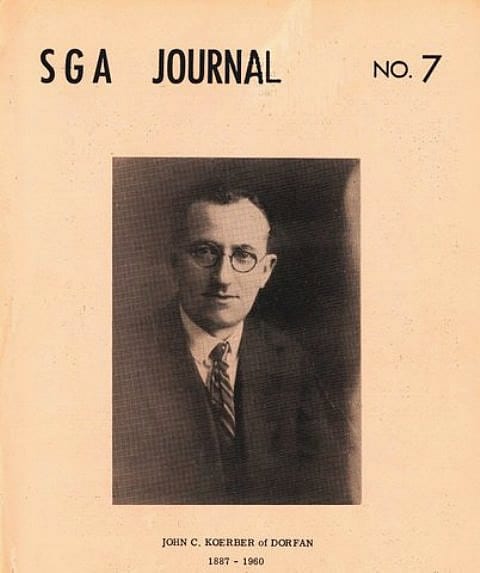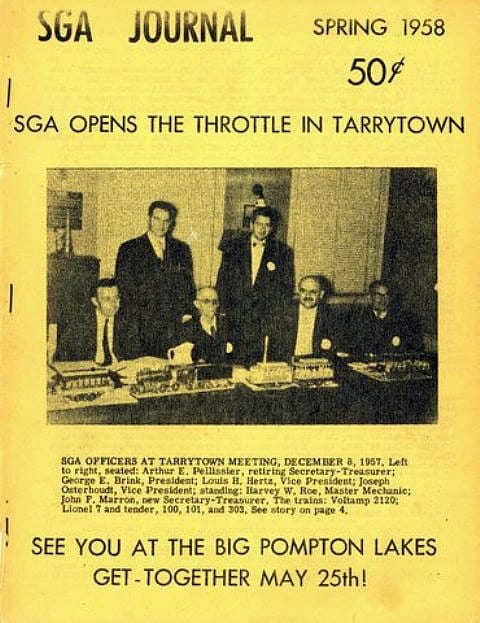The Newsletters of the Standard Gauge Association (SGA)
By Roger A. Rydin, TCA# 95-41024 Winter, 2017
About 10 years ago, I purchased a stack of old mimeographed newsletters from Donny Mays at the Antiquers Mall in Charlottesville, VA. They were originally owned by Stanley Stahl, who was a member of the Standard Gauge Association (SGA). Most of the stack consisted of issues of Tinplate Review, edited by Alan T. Short, a Protestant minister who originally came from NYC, but then worked in Pennsylvania and finally in Maine. He began to write in the 1940s, and continued until 1972, lamenting the sad state of Lionel at its decline. The newsletters abounded with drawings of specific trains sketched by Short himself.
The rest of the stack from Donny consisted of issues #3 to #7 of the SGA Journal from 1958 and 1959. I wondered whether there were more of them somewhere, but someone told me those were the last ones issued.
Last week, Peter Primiani and I went to see the Dorfan collection of John Wheeler, who collects not only the trains but also all of the paper and catalogs he can find. He had the missing SGA issues #1 and #2, and let me borrow them to scan. That gave me the opportunity of going through them in order to learn something about the SGA, which I will summarize here.
All issues were 24 pages. Issue #2 tells the history of the SGA. It was founded in 1947 as an association of train collectors, historians and dealers, centered near NYC. For the early years, it functioned mostly by mail and private meetings, with only the issue of three Guides and two Supplements. The annual dues were $1. But in 1958, probably at the urging of Louis H. Hertz, they began to have meets and incorporated as an Association with the goal of putting out a quarterly Journal. The dues rose to $2 and then to $3 a year.
<sga1p1.jpg> The first issue #1 in Spring 1958 describes a past meet at Tarrytown, NY, and announced the next meet in Pompton Lakes, NJ. The President of SGA wrote, “We have rallied to come through trying times, and there is no truth to rumors of our merging with a (unnamed) rival organization we have already declined to join.” It was suggested that they should buy a plaque for the old Ives factory in Bridgeport, CT. There were major articles by Gerard A. Robinson (Doc Robbie) on the Ives Circus Train, and by Louis Hertz on Lionel brass locomotives and Ives catalog variations from 1901 to 1910. I have most of those Ives catalogs, some original and some reproductions, but not all variants. My 1905 version was stamped Wanamaker. There were a few other short articles, and then some common features of all the Journals, namely Q&A, New Finds, Letters, Prices and Sales & Swaps.
From the Train Collectors Association (TCA) website, we find that: “A few years earlier, in 1954, Bill Krames and Edwin Alexander issued invitations to collectors to meet at Alexander’s Train Barn at Yardley, Pennsylvania. This meeting resulted in another call for collectors to form an organization. Meanwhile, in Southern California, Evan Middleton called together collectors who then met and formed the Western Chapter, later redefined as a division of what was to become a national organization.” The result of these two meetings was the formation of the TCA, which apparently was the rival organization mentioned in issue #1.
Issue #2 in Summer 1958 recounts the meet at Pompton Lakes and gives the history of the SGA. The next meet was set for Mamaroneck, NY. There were major articles by Gerard Robinson on the Ives 1134, and by Louis Hertz on Pairs and Triplet Variants and Ives catalogs from 1910 to 1924. Again there were the common features of Q&A, etc.
Issue #3 in Fall 1958 discusses the two day meet coming to Bridgeport and the meet at Mamaroneck. There was a list of contributors to the Ives plaque Fund, and a list of SGA Members totaling about 280, including Jim Crone of VTC, Al Franceschetti who sold us parts, Stanley Stahl and LaRue Shempp whose fine collection is in a museum in Williamsport, PA. There was only one major article by Louis Hertz on Boucher, plus the usual common features.
Issue #4 in Winter 1958 discusses an appearance of SGA at the Antique Show in Madison Square Garden. There was a discussion about lateness of the previous issue. This was blamed on lateness or non- payment of member dues. The major articles were by Gerard Robinson on the Ives Holland Avenue factory in Bridgeport, by Louis Hertz on Lionel Variations and Ives catalogs from 1924 to 1929, and by Roger Arcaro on Hafner and Marx.
Issue #5 in Spring 1959 mentions the upcoming Hershey, PA meet, but was dedicated to the Ives Plaque presentation. The description of the event had no author listed, but was quite extensive with lots of photos taken at the ceremony. Louis Hertz contributed a separate article on Bridgeport and Roger Arcaro wrote an article on Marx. I scanned the Ives information on the plaque ceremony and published a summary in Ives Ties a few years ago.
Issue #6 in Summer 1959 mentions the problem of lateness again. The major articles were by Gerard Robinson on the Ives 3242, by Robinson and Hertz on an extensive list of train prices, by Hertz on Lionel and American Flyer, and by Arcaro on Marx and Hafner.
The final issue #7 Fall 1959 shows no sign that it would be the last one! There was a lot of grousing about the way the Hershey meet went on, calling it disappointing. It seemed to be a conflict between collectors and some dealers who interrupted the business meeting with their loud selling. There were major articles on Dorfan, including an obituary on John Koerber which gave historical data on the company. Louis Hertz wrote about Dorfan Standard Gauge, and Gerard Robinson wrote about the connection between Fandor and Dorfan. In many ways, there is more information on Dorfan and Fandor in this issue than anywhere else. At this time, Robinson had become the Editor.

The SGA Journal then came to a sudden end! It came even though Hertz had promised to finish the descriptions of the Ives catalogs printed after 1929 in the next issue. Looking at the SGA in totality, it seems apparent that Louis Hertz and Gerard Robinson were doing almost all the unpaid work to keep it going on a shoestring, and were only helped in article writing by Roger Arcaro. Perhaps they tired of doing it all themselves and simply gave in to their rival competition which had already become a national organization.
An explanation comes from the TCA library:
We have correspondence in the Library from Lou Redman which provides some insight into the reasons for the gradual demise of SGA. Some contributing factors mentioned are that:
1) Although SGA was the older of the two groups, it never achieved the level of organization necessary to sustain a large collector’s organization;
2) The SGA lacked strong positive leadership. Its competition with TCA arose out of issues of jealousy and egoism on the part of Louis Hertz supported by a small group of followers;
3) In its early years the SGA was very limited in scope and admitted only Standard gauge collectors;
4) TCA offered more benefits to its members from the outset. It initiated an effective advertising campaign, organized and incorporated early, had a central meeting place and held regular meets, published an impressive magazine and accepted members with all collecting interests;
5) Officers in SGA held positions for only short periods of time. Some resigned or changed positions and others left SGA for TCA. This factor contributed to instability within the organization;
6) President Emeritus and outspoken opponent of TCA, George Brink, died in April of 1962. He may have been a factor in its demise too.
So now you know “The rest of the story.” SGA operated for more than sixteen years as a small scale, low membership, mostly eastern organization, with little in the way of meets, publications or interests other than standard gauge. A new national organization formed in 1954, and soon began doing all the things that SGA had decided not to do. SGA was invited to join them, but angrily declined. Instead, they tried to compete by incorporating, scheduling meets and starting a regular publication, the quarterly SGA Journal.
But SGA did not have the firepower to compete with TCA. Hertz, Robinson and Arcaro could not do it all alone solely from an eastern base. There was dissention and there were defections, and finally they just gave up the ghost and went out of business with hardly a whimper being heard.
NOTE: Trivia from the TCA’s National Toy Train Library, which has copies of the SGA membership lists and other information on this Association.






